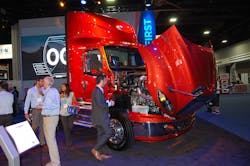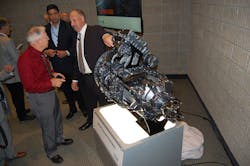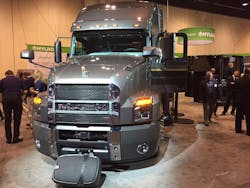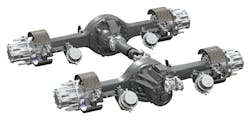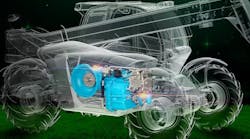Eliminating the need to manually shift gears makes operating a commercial truck easier and usually safer as well. Automated shifting also can help improve fuel economy, which is a trend documented by the North American Council for Freight Efficiency.
Recent research from that group found that fleets are realizing a 1% to 3% improvement in fuel economy by using automated manual transmissions (AMTs) over manual gearboxes. That’s why many OEMs report that AMTs and fully automatic shifters like Allison Transmission’s TC10 are becoming the dominant spec’ing choice among fleet customers—to the point where several manufacturers are making automated gearboxes their “standard” transmission spec.
“In 2017, approximately 70% of our linehaul customers purchased automated transmissions, up from about 30% in 2013,” noted Kurt Swihart, marketing director for Kenworth Truck. Its brother company, Peterbilt Motors, is experiencing a similar uptick.
By 2020, Kenworth expects AMTs to make up 90% of its linehaul orders. As a result, last December the company made the 12-speed proprietary AMT built by its parent company PACCAR the standard transmission offering for its T680 tractor for both linehaul and regional applications.
“AMTs have become more popular, and 70% of fleets are ordering [them] in both Kenworth and Peterbilt over-the-road trucks,” explained Landon Sproull, vice president of PACCAR. “They help drivers reach peak performance sooner with optimized shifting and intuitive control features. Training is therefore simplified and less time consuming. Running trucks that are easier to operate helps fleets expand their pool of [driver] recruits.”
“AMTs and full automatics are becoming increasingly popular, [and] we’re now seeing in the neighborhood of 90% of our highway trucks,” added Scott Barraclough, technology product manager for Mack Trucks.
“On the vocational side, the combination of AMTs and full automatics also makes up a significant percentage of what is spec’d as well, with our mDRIVE HD AMT accounting for nearly 50% on its own.”
Yet several questions spring to mind: Does this mean the manual shifter is on the road to extinction? And if the industry continues to switch to automated gearboxes, how does it impact a fleet’s overall powertrain spec’ing process?
Manual shifters will stay
First off, manual transmissions are not going away anytime soon, noted Barraclough, but their overall numbers will decline.
“There are certain niche applications where manuals are still preferred—very heavy haul with auxiliary transmissions and pumping applications with drop boxes come to mind,” he explained. “Although it won’t be long before AMTs penetrate these niches as well.”
Jim Nachtman, Navistar’s heavy-duty product marketing director, added that the ability to computer-control gear shifts via an AMT will lengthen clutch life and help broadly optimize fuel economy, especially using predictive cruise control when operating in hilly terrain, which requires a lot of skill to achieve when manually shifting gears.
“The manual transmission is still popular in niche applications like heavy haul, but in general, we’re seeing the ‘take rate’ consistently increasing for AMTs month-over-month and quarter-over-quarter,” he noted. “Our recent [order] data for our new LT tractor shows 75% are spec’d with AMTs, and we expect much higher [levels] in the coming months.”
While there is a “noticeable movement” toward more use of AMTs and fully automatic gearboxes, Kelly Gedert, director of product marketing for Freightliner and Detroit components, divisions of Daimler Trucks North America (DTNA), said manuals will “continue to be offered” based on demand, which includes customer preference and specific application types.
“In 2017, for example, our Detroit DT12 AMT was ordered on approximately 70% of all combined Freightliner Cascadia and Western Star 5700XE on-highway models, but manuals were still ordered on 20% to 25% of all transmissions sold in all Freightliner and Western Star models last year,” Gedert said.
John Moore, product marketing manager-powertrain for Volvo Trucks North America (VTNA), echoes that outlook where manuals are concerned. “Manual transmissions are not a thing of the past but face ever-mounting pressure from AMTs and full automatics as enhancements are made to these transmissions that allow them to operate in areas that were restricted in the past,” he explained.
“For example, our 13- and 14-speed I-Shift with crawler gears was developed to allow it to be used in applications that required a deep reduction start gear for startability on soft ground or sand, or applications that have to back up at a crawl speed to connect to an expensive trailer without damaging it,” Moore said.
“Manuals were preferred here in the past because the driver could use the clutch to slowly engage the driveline—something AMTs could only dream about until now,” he stressed.
Still, Moore thinks it will be “quite some time” before manual transmissions are completely replaced by AMTs and fully automatic gearboxes simply because of customer preference. “Despite its prevalence in 90% of all trucks we build, not everyone has bought into the AMT revolution for various reasons,” he noted. “Some drivers just like to shift.”
“The use of manuals is typically dictated more by customer/driver preference than by application,” DTNA’s Gedert added. “The ever-increasing availability and technical coverage of AMTs and automatics is expanding coverage for many additional applications.”
Indeed, Shane Groner, director of field business development at the Eaton Vehicle Group, stressed that manual transmissions continue to be a “very reliable” and “cost-effective” option for trucking companies and their drivers alike. “Manual transmissions currently continue to make up approximately 50% of the total North American Class 8 market,” he noted.
While that number will decline over time because of fleets transitioning to automation to enable a larger driver pool population, Groner thinks automated transmissions won’t fully displace manual transmissions in the foreseeable future.
“For a fleet that is looking for the simplest, most reliable product on the road, a manual transmission continues to be very hard to beat as it is simple, reliable and can enable a very low total cost of ownership,” he emphasized.
Rear axle ratios more critical
One powertrain spec’ing point that is becoming more critical now and more critical going forward is the rear axle ratio. Jason Owens, powertrain relationship manager at Cummins, said this component can “make or break” a truck’s ability to achieve the best fuel economy.
“I can put the best engine and transmission together, but if I miss on the axle ratio, I’ve thrown away all the fuel economy benefits,” he explained.
“Look at long-haul operations out on the road a week to 10 days and traveling mostly at interstate great speeds—drivability here is a big factor. So you are spec’ing for 96% of the truck’s time to be on-highway and to operate at interstate speeds,” he said.
But when you look at regional- and short-haul operations on two-lane roads in stop-and-go traffic density, Owens said, you cannot use a long-haul highway axle ratio in that application.
Navistar’s Nachtman agrees. “The rear axle ratio is absolutely critical for attaining optimal fuel economy,” he emphasized. “What we typically spec in a LT over-the-road tractor is a 2.64 rear axle. That provides optimal balance between fuel economy and performance.”
While Navistar does offer a 2.47 rear axle ratio to achieve even better fuel economy, that spec reduces performance.
“It’s about getting good but perhaps not ‘optimal’ fuel economy while retaining more performance for the driver. That is why we offer a whole host of rear axle ratios, so we can really tailor the vehicle to fit the customer’s needs.”
For example, rear axle ratios are often spec’d higher in some regional haul applications. Those trucks get more acceleration performance since they are in more stop-and-go traffic while more frequently merging on and off highway ramps.
“And it’s not just a matter of regional versus long haul,” he added. “It’s about trailer types, overall vehicle speeds, and loads that are hauled. Lowboy flatbed trailers require a tractor to have a different rear axle ration than dry van units. The type of terrain and time spent on steep grades; those matter, too. There are a lot of things to consider.”
“It’s best to set up a powertrain to match the application to achieve the highest efficiency,” added VTNA’s Moore. “Some customers that run the full gamut cannot control at times where their vehicles may end up, so they will need a spec that can do it all. It’s all about asking questions: How much time is spent in long haul versus regional haul? If the answer is 5% of the time [in regional haul], why would you sacrifice fuel efficiency for the 95% of the time you are on the highway? This is where I advocate separate specs.”
Accommodating new drivers
Perhaps the biggest factor affecting the powertrain spec’ing process today is the shift in truck driver skills as a generation almost completely unfamiliar with manual shifting enters the industry in ever-increasing numbers.
“Younger drivers are almost expecting automatics or AMTs,” explained Mack’s Barraclough. “Many have not been exposed to a manual transmission in their cars and have no appetite to drive one in their trucks.”
“We look at the driver shortage and feel an AMT or fully automatic transmission will allow a larger amount of driver candidates to be qualified,” Navistar’s Nachtman said. “That helps fleets hire and retain drivers simply due to easier drivability of their trucks.”
“The driver shortage in North America has definitely had an impact on powertrain designs and on fleet specification decisions,” Eaton’s Groner pointed out.
“As a means to increase the available driver pool, considerable effort has been made to make trucks operate more like cars from a driver interface and driver interaction perspective,” he explained. “Fleets have moved to automation to reduce the skill level needed to safely operate a Class 8 tractor-trailer on public roads.”
Groner added that while a veteran driver will continue to have the skills necessary to operate any transmission provided to them, even for them automation provides safety and health benefits because of the “easier operating characteristics” of an automated system.
DTNA’s Gedert added that while AMTs and automatic transmissions are becoming more and more popular with drivers of all experience levels, one advantage they offer for new, less-experienced drivers is the potential to get them into a “revenue-producing situation” faster by reducing the amount of training time required to operate a commercial vehicle.
Yet Brett Merritt, executive director of the on-highway business for Cummins, pointed out that it is still “tough” to say whether driver needs are changing powertrain technology or if the technology is changing the driver.
“Clearly, automation is changing things; automated products are producing better fuel economy and good drivability at a cost that is not penalizing the end customer,” he explained. “That allows them to access different drivers than before. Manuals will stay for the foreseeable future [as] we will need them for specific use cases. But there will be more and more [powertrain] automation over time.”
Five driveline tips for powertrain spec’ing
Each fleet must consider its unique requirements and factors of importance when considering its optimum powertrain specification, explained Steve Slesinski, global director of product planning for the commercial-vehicle market at Dana Inc. “Regardless of the transmission type, it is important to integrate the entire powertrain in order to optimize truck performance,” he stressed.
To that end, Slesinski offers the following driveline “considerations” to keep in mind during the powertrain spec’ing process:
1. Application, Duty Cycle, and Weight: Universally, fleets emphasize the importance of reducing downtime and operating costs. But truck application and duty cycle influence how powertrain components should be spec’d. A bulk hauler might spec for weight savings, while vocational truck owners may place a higher value on durability, Slesinski said.
“Duty cycles factor into axle selection, and the axle and ratio should match the truck’s performance requirements for the intended application,” he pointed out. “For diminishing-load applications, a fleet may want to spec a smaller axle to save on initial investment. The lightest weight configuration will also allow for increased load capacity. But if a lighter axle is overloaded, it may result in early repair bills. If over-specified, the fleet may be spending more than necessary and hauling around extra weight.”
2. Operating Environment: Fleets should consider anticipated terrain, grades, and speed. Those factors determine which axle configuration will be most effective, Slesinski noted. “A 6x4 axle configuration can provide the added traction needed in foul weather or on steep grades with dual differential locks, while 6x2 drive axles tend to be better suited for primarily dry-weather conditions over flat, smooth pavement when torque on all four wheel-ends is not critical.”
3. Engine Size, Horsepower, and Torque Needs: The selection of engine and transmission combinations determines the torque required to deliver an optimum power level, he said. “Spec’ing the axle and driveshaft to handle torque loads is important. Thus it is an important consideration to select the proper axle ratio, as the desired vehicle performance or fuel efficiency will be impacted,” Slesinski emphasized. “The lower the axle ratio the higher the torque input into the driveshaft and axle system.”
4. Service Requirements: Proper lubrication can improve fuel economy while extending component service life and reliability. “Consider a ‘service-free’ driveshaft or re-lube design that offers savings by extending maintenance intervals and offers commonality of service part interchangeability for maximum uptime,” he said. “In addition, weigh available warranty options. Longer warranties can mitigate the risk of high operating costs over the life of the vehicle. Axles qualify for extended lubrication intervals and the longest warranties when the manufacturer’s specified synthetic lubricant is used.”
5. Resale Value: The way a new truck is spec’d also impacts its value when it reaches the “secondary market” down the road. “Products that are proven to be reliable in the marketplace tend to improve resale value,” Slesinski said. “For example, more recent AMTs can add a premium to resale value, while some of the older models may not. Tandem drive axles offer the best resale value versus 6x2 configurations.”

